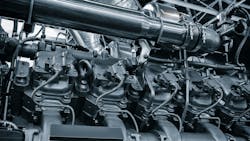Engineering Basics: How to Select Diesel Engines for Critical Process Equipment -Part 1
Diesel engines have been popular as drivers for equipment such as pumps, compressors, generators, fans and blowers. They are known for their high torque, high power density and compact configurations. These engines produce higher power and torque at relatively low speeds compared to other internal combustion engines. Most importantly, they offer efficient and flexible use of fuel with high energy density, enhanced safety and excellent storage and distribution options.
In chemical processing facilities, this reliable power generation is critical for maintaining continuous operations of pumps, compressors, generators and other essential equipment.
However, it’s important to match the right diesel engine for a particular application. Proper size, power rating, torque and other parameters at the right cost determines the success of the diesel engine in chemical processing operations.
Modern Advancements: Today's Cleaner, Quieter Diesels
The diesel engine uses the heat of compression to initiate the ignition and burn the diesel fuel. Diesel is injected, typically at a very high pressure, into the combustion chamber, or cylinder. The thermal efficiency of the diesel engine is very high due to the use of a high compression ratio, one that’s typically far higher than what’s found in gasoline or gas engines.
Modern diesel engine designs have been optimized to improve fuel economy and meet more stringent emission standards. They also are smaller than older-style diesel engines to help lower costs, enable more compact configuration and reduce weight.
These are important characteristics to note as traditional diesel engines had a stigma attached to them due to nitric oxides (NOx) and particulate matter (PM) emissions, high noise, greater vibration and other issues. Over the last 30 years, engine makers have addressed these issues by incorporating advanced technologies, including common rail fuel injection systems, exhaust gas recirculation and sophisticated turbocharging to meet stringent environmental standards without sacrificing performance.
Operating Parameters to Consider
In diesel engines, the injection system sprays fuel into compressed hot air, causing it to evaporate and auto ignite beyond flash and fire-point temperatures, thereby leading to combustion. As a rule of thumb, most of the combustion phenomenon is completed within 10 milliseconds for approximately 2,500 rpm of engine speed. The combustion might be assumed as stoichiometric when the air/fuel mixture is such that there is no remaining fuel or oxidant.
Both power rating and torque are important for the sizing and selection of a diesel engine. The power rating is particularly important for continuous operation, while torque is a critical consideration for start-up and different transient cases.
Other key parameters include brake mean effective pressure (BMEP) and best efficiency speed (BES).
BMEP is an average value of the pressure inside the cylinder, and if it is applied uniformly over the power stroke instead of the actual non-uniform power stroke, then the engine will produce the same amount of brake power as an actual engine, which typically has a minor impact on fuel efficiency.
BES is the optimum speed where an engine offers maximum efficiency. Ideally, the operating speed should not exceed this BES to minimize fuel consumption. In general, higher speed and higher rating do not help with fuel efficiency, unless the power train is more efficient when scaled up.
As a very rough indication, the most fuel-efficient speed for many four-cylinder and six-cylinder diesel engines is somewhere in the 8-10 m/s range. Considering turbocharging, modern engines are usually configured at a relatively low operating speed of the piston. Nine m/s might be assumed as the mean piston speed for a reasonably good efficiency.
Diesel fuel offers a higher volumetric energy density than many other fuels, such as gasoline. Typically, diesel contains hydrocarbons with a boiling point in the 180–360°C range. Conventional diesel flashpoints vary between 55°C and 95°C. Therefore, diesel is often safer to use than many other fuel types. As an indication, the average chemical formula for common diesel fuel is C12H23, ranging approximately from C10H20 to C15H28.
Additionally, cetane number (CN) is a property of the diesel fuel that indicates the speed of the combustion within the cylinder and is inversely proportional to the ignition delay. CN of a diesel fuel varies between a scale of zero and 100 with methylnaphthalene (CH3C10H7, long ignition delay [poor ignition quality]) at 0 and cetane hexadecane (C16H34) [short ignition delay] at 100.
The higher the cetane number, the shorter is its ignition delay and hence the fuel is more easily combustible leading to higher combustion efficiency and low hydrocarbon emissions. However, due to high cylinder pressures favoring fuel cracking, particulate matter emissions might increase.
As a rule of thumb, an increase in 5% of CN may lead to an increase in particulate matter generation by 30%-35%. Low cetane number fuels lead to misfiring, undesirable engine deposits, high hydrocarbons emissions, and rough running. Most modern diesel fuels have a minimum CN of 40.
Selecting the right diesel engine for chemical plant operations requires more than just matching horsepower and torque. Engineers must also consider key parameters like BMEP, BES and air-fuel ratio to ensure reliable, efficient performance. A solid understanding of how engine speed, load and fuel properties influence combustion dynamics can help avoid mismatches that lead to performance shortfalls or emissions issues.
In Part 2, we’ll explore how modern diesel technologies — including turbocharging, advanced fuel injection systems, exhaust gas recirculation and valve dynamics — further optimize performance and support compliance with today’s stringent environmental regulations.
About the Author
Amin Almasi
rotating equipment consultant
AMIN ALMASI is a mechanical consultant based in Sydney, Australia. He specializes in mechanical equipment and offers his insight on a variety of topics including pumps, condition monitoring, reliability, as well as powder and fluid handling and water treatment.

